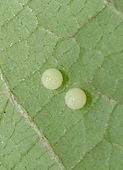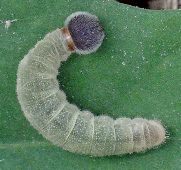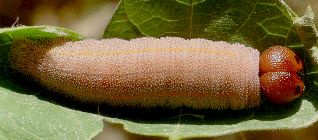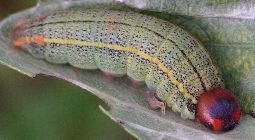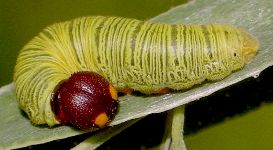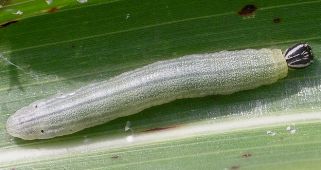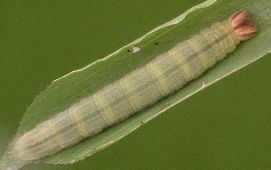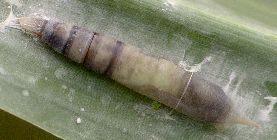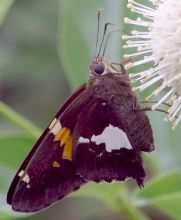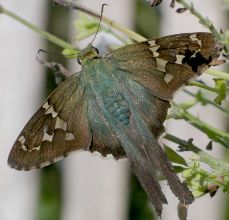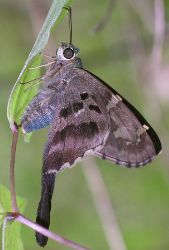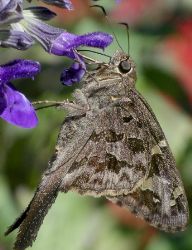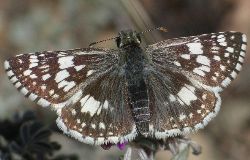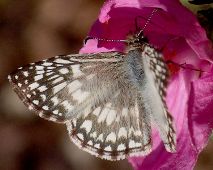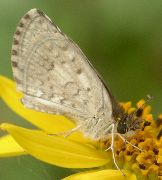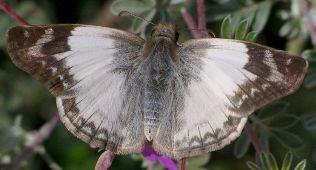
| Hesperiidae ~ Skippers |
|
The skippers constitute a large family of mostly small butterflies. They differ from all other butterflies in several ways, including wing venation, the club of the antennae being bent, and the head and body being fairly big compared to the wings. Skippers tend to fly very quickly and erratically. There are two main groups in our area: the spread-wing skippers and the grass skippers.
I have only seen one member of this family laying eggs, and that is the Long-tailed Skipper (Urbanus proteus). The females I've seen deposited their eggs in pairs on leaves; in this case the host was Hyacinth Bean (Lablab purpureus), and the eggs were small, round and white. I never found any caterpillars afterwards, and suspect that predators got either the eggs or the young larvae.
The caterpillars of skippers are rather smooth, with very short hairs on their bodies that are usually hard to see. The heads look relatively large and there is often a constriction at the neck so that it looks like the head was stuck onto the body. Skippers almost all make shelters in which they hide. They tie leaves together or cut a piece of leaf and then use silk to hold the pieces together. Grass skippers roll a piece of grass in the same way. They come out to feed at night. Because they are nocturnal, the only way to find the caterpillars is to check host plants carefully. Pictured here are the species which I have been able to find, often with the help of friends who know each larva's host plant. The Texas Powdered-skipper (Systasea pulverulenta) is a small caterpillar that folds over a piece of a leaf on Velvetleaf Mallow (Wissadula holosericea). It has a reddish-brown head, but the body color matches the leaves very well. A similarly small species, Hayhurst's Scallopwing (Staphylus hayhurstii) caterpillars feed on a weed called Pitseed Goosefoot (Chenopodium berlandieri). Their head is black and covered with white fuzz. The caterpillars of tailed skippers can get rather large. They prefer legumes with wide leaves and which grow as vines. Larvae of the White-striped Longtail (Chioides catillus) turn a pink color when they are mature. Their orange head has two black dots that look like eyes (but are not). The Long-tailed Skipper (Urbanus proteus) caterpillar is green with yellow stripes down its sides. Its head is orange and brown, with a large black section in the middle. The tail end of the caterpillar is orange.
Another large caterpillar is that of the Silver-spotted Skipper (Epargyreus clarus). This tailless butterfly is closely related to the tailed ones, and the larvae are also similar. The mature caterpillars are bright yellow-green with a brown head sporting two bright orange spots. I have found these on both Wisteria (Wisteria macrostachya) and False Indigo (Amorpha fruticosa).
Prickly Ash (Zanthoxylum hirsutum) is the host plant of the Sickle-winged Skipper (Achylodes thraso). The caterpillar's body is green with yellow side stripes and the head is heart-shaped. While a good number of spread-wing skipper caterpillars are not too hard to locate, the grass skippers are another matter. Perhaps it is because there is just so much grass around, but even with searching it is difficult to find these larvae. I've seen only two species. One is the very common Clouded Skipper (Lerema accius), which prefers the big leaves on Johnson Grass (Sorghum halepense). Grass skippers tend to have smaller heads and the markings on them are important for identification. The other larva in this group which I've seen is that of the Eufala Skipper (Lerodea eufala). The head of this one is orange and brown.
The pupae of skippers don't look much like those of other butterflies and they are usually called pupae rather than chrysalises to show the distinction. In the case of the grass skippers, the pupa is surrounded by silk and held in place within a curled leaf. It has a pointy head. There are some very easily identified spread-wing skippers in our area. The Silver-spotted Skipper (Epargyreus clarus) is a large dark brown butterfly with long pointed forewings and white patches on the undersides of the hind wings. In addition to those marks, there are orange glassy patches on the forewings. This particular species rarely sits with wings completely open. More often they are held together or just slightly separated.
Take the general shape of the Silver-spotted Skipper and add tails to the hind wings and that describes our tailed skippers. My favorite is the Long-tailed Skipper (Urbanus proteus), which has beautiful blue shading on its back. This skipper does sometimes rest with wings open, but more often holds them back as it feeds. The flashes of blue, though, make identification fairly easy. Much less common is the Dorantes Longtail (Urbanus dorantes). This brown butterfly has various brown markings on the undersides of the wings like the Long-tailed Skipper, but they are more broken up into small spots instead of large bands. There is also no hint of blue on the upper side of the insect.
One other tailed skipper is common here and that is the White-striped Longtail (Chioides catillus). This species has the longest tails of any, but they are easily broken off. When that happens, it could be confused with the Silver-spotted Skipper. However, the shape of the white marks on the undersides of the hind wings are quite different in the two: the White-striped Longtail has a narrow white stripe (as suggested by its name) while the Silver-spotted Skipper has a larger and more irregular white patch. There are several white spread-wing skippers. They will not be confused with white butterflies in the Pieridae family because they are shaped so much differently. The most frequently encountered of these, though, cannot be identified to the species level because we are at the overlap of two identical species' ranges. These are the Common Checkered-white (Pyrgus communis) and the White Checkered-skipper (Pyrgus albescens). According to range maps, we are much more likely to have the former than the latter, but butterflies do not often stay within the lines. Because these two species can only be distinguished by dissection, for practical purposes I will just call them Common/White Checkered-skippers. Males tend to have much more white than females but the amount of white vs. black varies considerably on individuals. These butterflies tend to fly all year and frequently nectar on tiny ground-hugging flowers during the colder months. They also often bask in the sun with their wings fully open so the extremely hairy upper area on their back is visible. This can be light gray or blue.
As if having two identical species isn't enough, there are also two other species that are extremely similar in appearance. The Desert Checkered-skipper (Pyrgus philetas) looks very much like the former species and has similar habits. There are two clues, though, to distinguish this one. There is a rather large raggedly square spot located near the center of the leading edge of the upper side of the forewing on Common/White Checkered-skippers. This same mark on the Desert Checker-skipper is accompanied by a second, more round, large spot on the outer side. On the Common/White complex, this second spot is absent or very tiny. The other detail to look for is in upper side of the forewing tips. Common/White Checkered-skippers usually have the edge dots peter out, so there is a more uninterrupted black area, while the Desert Checkered-skipper has a full compliment of the white edge dots all the way to the front edge of the wing. One other characteristic that helps is that the series of dots on the edges of the upper sides of the hind wings are usually larger on the Desert Checkered-skipper (but these do vary a lot). I know this all sounds very complex, but these clues together really do make it possible to distinguish the Desert Checkered-skipper, which is not all that common here. The last species that is also similar is another less common one. The Tropical Checkered-skipper (Pyrgus oileus) has the same large round marking next to the square one as is found on the Desert Checkered-skipper. It also has similar edge spots. The big difference is in the forewing fringe. On both the Desert and the Common/White Checkered-skippers, the fringe is evenly marked with white and black spots. However, on the Tropical Checkered-skipper, the white spots on the front wing disappear near the front tip, leaving a section of all-black fringe. Of course, this can be worn off, but it is usually quite evident on most individuals.
Although the tops of the wings are more often seen, the undersides of the wings of all three species are also different. The Tropical Checkered-skipper tends to be darker and there are three long, evenly spaced dark spots on the front edge of the hind wing. The Desert Checkered-skipper is very light underneath, and there is a small dark marking near the center of the hind wing that arches out like a parenthesis rather than the sharply angled point of the equivalent on the Common/White Checkered-skipper. The Common/White Checkered-skipper has brown and tan markings which contrast much more than on the Desert Checkered-skipper.
An even more white skipper is the Laviana White-skipper (Heliopetes laviana). This species has large unmarked white areas on the upper sides of the wings, although the female has more extensive gray marks. The underside markings on the hind wing are very distinctive, especially the dark mark that looks like a "Y" on its side.
|
![]()
